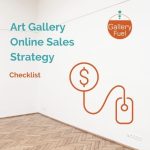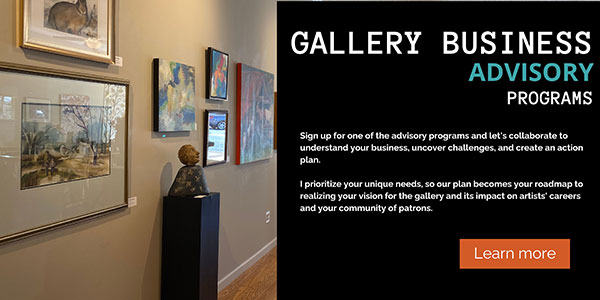Selling gallery art can be an intimidating task for many people, but it’s important to remember that sales are what keep the gallery space running. In this blog post, we will explore some tips to help you create a solid mindset when engaging in sales conversations with art collectors, ultimately eliminating anxiety and ensuring a successful experience.
Creating a Memorable Experience
When collectors visit your gallery, it is crucial to provide them with a memorable experience through exceptional exhibitions, gallery service and knowledgeable sales associates. That’s a given. But what other aspects of buying art contribute to a memorable experience. The experience they have at your gallery is vital because collectors often share their experiences and discuss their collections with like-minded friends.
Here are some ways your gallery can Fuel the experience you provide collectors:
- Exceptional Customer Service: Provide personalized and attentive customer service throughout the entire buying process. Greet visitors warmly, engage in friendly conversations, and actively listen to their needs and preferences. Be available to answer questions, offer insights, and guide them through their art-buying journey.
- Curated Walls: Present the artwork in an aesthetically pleasing and thoughtfully curated manner. Consider the flow of the gallery space, how artworks are arranged, and how they interact with each other. Engage visitors by providing context, descriptions, and explanations that enhance their understanding and appreciation of the artwork.
- Interactive Elements: Incorporate interactive elements or multimedia displays that allow buyers to delve deeper into the art, such as digital presentations, artist interviews, or behind-the-scenes videos. These interactive experiences can add layers of engagement and make the art-buying process more immersive and memorable.
- Added Value Services: Offer additional services that enhance the buying experience, such as art consultations, custom framing, installation assistance, or after-sales support. Going the extra mile to assist buyers with their art-related needs shows your commitment to their satisfaction and creates a memorable experience.
- Attention to Detail: Pay attention to the small details that contribute to a positive experience. This includes providing comfortable seating areas, offering refreshments, maintaining a clean and inviting space, and ensuring clear and informative signage.
Follow-Up and Relationship Building: After the sale, maintain contact with buyers by sending follow-up messages, personalized updates about new artworks, or invitations to future events. Building and nurturing relationships with collectors reinforces their positive experience and encourages their continued patronage with the gallery.
By incorporating these strategies, a gallery can elevate the art-buying experience and leave a lasting impression on collectors, fostering loyalty, and generating positive word-of-mouth referrals.
Sell Yourself First before Selling Gallery Art
Gallery sales associates are a crucial asset for boosting gallery profits. When it comes to luxury sales, it’s actually pretty cool to sell yourself before selling a product. In the art business, it’s all about building relationships first and foremost, rather than just focusing on making sales. Even a quick interaction can contribute to the relationship-building process if it’s engaging and positive. Selling your personality to a client before diving into specific artworks is often a major factor in successfully sealing the deal.
So, start conversations openly to create trust and let the client express their needs. Show off your awesome personality and knowledge, so potential buyers feel like they’re in good hands. Building a strong rapport will reassure clients that they’ve received great guidance and make them confident in their decision to make a purchase.
Before you know it, closing the sale becomes a piece of cake.
Inspire with Confidence
Productive sales conversations require complete confidence from the sales associate regarding the artist and specific artworks. Associates must be able to advise prospective clients intelligently, meeting their unique requirements. Confidence cannot be faked. When sales associates are confident in their expertise, they also find more enjoyment in the sales process.
Here are some tips for gallery sales associates to boost their confidence in selling:
- Expand your knowledge: Keep learning about the artists and artworks in the gallery. This way, you can provide smart advice to potential clients and meet their unique needs.
- Understand the gallery’s value: Make sure you know how to explain the value that the gallery brings to the buying process. Understand the gallery program, artist selection criteria, and services offered to collectors. Being able to talk about these things will make potential buyers more confident in their decision.
- Keep training: Regular training sessions are important for building confidence. Stay updated on industry trends, new artists, and sales techniques. Confidence can’t be faked, so ongoing training is crucial.
- Embrace your expertise: When you’re confident in your knowledge, you’ll enjoy the sales process more. Trust in your abilities and embrace your expertise. This will naturally boost your confidence when interacting with clients.
By following these tips, gallery sales associates can enhance their confidence in selling and have more successful sales conversations.
Demonstrate you have the Client’s Best Interests at Heart
Remember that the experience of finding, buying, and living with art is special. An art gallery sales associate should always demonstrate that they have the client’s best interests in mind during conversations. It is perfectly acceptable for clients to take their time, leave the gallery to think about their options, and return or follow up in a few days. This should not be seen as a failure. If there are any concerns or apprehensions about making a purchase, allow the client to articulate them, be empathetic, and demonstrate that the gallery will work with them to find the perfect piece.
Patience is a Virtue When Selling Art
In gallery sales, the cycle can often be longer compared to other industries. Selling art is not just about closing a deal; it involves building relationships and establishing trust with collectors. You know that. This is where patience becomes paramount. Gallery associates must understand that art collectors are on their own unique journey, and it takes time for them to make decisions and feel confident in their choices. After all, art is a luxury and makes such a personal statement about themselves. They want to get it right when they add a piece to their home.
By approaching each encounter as an opportunity to guide collectors along their artistic exploration, you can create a lasting rapport. Building this connection is crucial in gallery sales because it allows collectors to feel comfortable and valued throughout the process. Patience plays a vital role in nurturing these relationships, as it demonstrates a genuine commitment to understanding the collector’s preferences, tastes, and aspirations.
When you invest time and effort into providing exceptional and helpful experiences, you can lay the foundation for future sales. By being patient and attentive, you can continue accompanying collectors on their journey. This approach not only increases the likelihood of making a sale but also fosters long-term loyalty and repeat business.
In gallery sales, patience is not just a virtue; it is a strategic advantage.
To the Point
Intimidation from selling art will diminish with experience. Begin each sales process openly to nurture trust and rapport, as they form the foundation of a strong gallery-collector relationship. While it’s understandable to have sales goals that can add pressure, by practicing the tips discussed here, you can ensure that the client never senses anxiety. Instead, they will feel valued and have a great time working with the gallery.
If the client believes that the gallery has their best interests in mind, prioritizing their experience over a mere retail transaction, they will undoubtedly remember that as part of their overall experience. Approach each sales encounter as an opportunity to participate in the collector’s journey rather than a mere pressure to meet a sales target. The result will be a relaxed process for both the seller and the buyer.
You may also enjoy these:
Six Quick Tips for Closing a Gallery Sale
How to create an integrated art gallery sales strategy.
 Checklist: Art Gallery Online Sales Strategy
Checklist: Art Gallery Online Sales Strategy



Thank you for all of this amazing information.